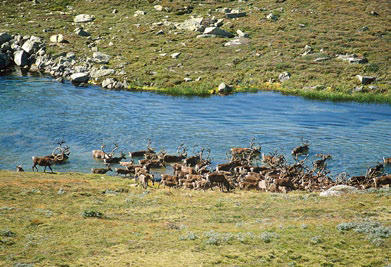Ole Reidar Vetaas as supervisor
Ole Reidar Vetaas supervises masters thesis within environmental and landscape geography with fieldwork in Norway or Nepal.

Main content
Fields of interest
I am interested in global environmental issues such as climate change, introduced species, and the threat to biodiversity. The current overarching issue is sustainable management of the natural and cultural landscapes.
I am generally interested in research that is based on geographical field data in combination with ecological data from digital archives. I have supervised many Norwegian and Nepalese master projects on forests and forest boundaries concerning climate change and land-use change. In Norway, I have focused on the problem of introduced trees and shrubs and their effect on the biodiversity of fruit farming. The globalized ecology creates new biogeographical challenges: for example, Fire blight bacteria from the USA spreads via Chinese Cotoneaster shrubs and may ruin the fruit farming in Hardanger.
Potential master thesis projects
1. Fruit farming in Hardanger: threatened by introduced species
Can the spread of Chinese cotoneaster bushes in Western Norway lead to Fireblight attack that might destroy fruit farming in Hardanger?
Cotoneaster shrubs are very common in Norwegian gardens and public properties. These shrubs spread in Norwegian nature and into our beautiful fjord landscapes. The Cotoneaster itself is not dangerous, but it may also be home to a dangerous American bacterium (‘Fireblight’) that attacks trees and shrubs in the rose family. Cotoneaster and all fruit trees belong to the rose family and are therefore very vulnerable to attack.
Linked to a pilot project on ‘Cotoneaster- invasion’ in the Hardangerfjord.
Fieldwork 4 -6 weeks in Hardanger.
Analysis of digital data is also very important in this project.
2. Adaptation to climate change for biodiversity
Have plants that like oceanic climate migrated further into our fjords due to climate change?
Climate change scenarios project wetter and warmer winters which means a more oceanic climate. We can use good historic plant geography data to check if these plants with an oceanic distribution have expanded further into the fjords.
Linked to a pilot project on Contoneaster in the Hardangerfjord.
Fieldwork 4 -6 weeks in Hardanger.
Analysis of digital data is also very important for tasks in this project.
Has global warming led to trees being established at higher altitudes than previously documented?
Both land-usechanges and climate change may influence the upward migration of trees in Norway as well as the Himalayas Reduced number of small stock and summer farmers contribute together with climate change to a dynamic upper limit of trees and shrubs.
Follow-up of a research project from 1997-2000
Fieldwork 4 -6 weeks in Nepal, Mt. Everest Area, Sagramatha National Park.
